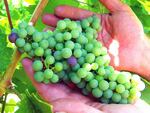
File photo of wine grapes from Washington state's Kiona Vineyards.
Anna King
When you pick up a bottle of Willamette Valley pinot noir, have you ever wondered how much of that wine is actually from pinot noir grapes or grapes grown in the Willamette Valley? There are actually strict rules about what can be labeled a “Willamette Valley” wine and which wines can call themselves “pinot noir.” And now some wineries are pushing the Oregon Legislature to make those standards even more stringent.
As it stands now, if there’s an American Viticultural Area — meaning a specific, established grape-growing region, such as the Willamette Valley — on the label, then 95% of the grapes have to come from that area. And if the label features a specific grape varietal — such as pinot noir — the wine has to be made from no less than 90% of that grape. Lawmakers are considering raising both requirements to 100%.
Proponents say it’ll help protect the character and cachet of Willamette Valley wines.
“A small amount of blending of a different variety or a different area of fruit can affect the character of a wine,” Willamette Valley Wineries Association president Mike McNally told OPB’s "Think Out Loud."
McNally is also co-owner of Fairsing Vineyard and Winery. He says the standards he and other winery owners want to codify are already widely used.
“The pioneers of the Willamette Valley that have established this wine character over the last 50 years have generally used 100% pinot noir, 100% chardonnay, and continuing that practice, that high-quality practice will continue our legacy and promote this authenticity too,” he said.
But some vineyard owners in Southern Oregon are concerned that the updated law could hurt their businesses. Michael Moore is the owner and vineyard manager at Quail Run Vineyards and a board member of the Rogue Valley Winegrowers Association. He sells a lot of his grapes to winemakers in the Willamette Valley.
“I work with about 45 different winemakers in the Willamette Valley, many of whom are opposed to this proposed bill,” he said.
Moore explained that the wineries he’s in business with will use his grapes as “blenders.”
“Blending has always been part of winemaking. It's a huge part of the creative process of winemaking,” he said.
Moore says that if proponents of changing the law get their way, he will have a lot of fruit he can’t sell. That’s because he’s planted grapes with the “blender” market in mind. And while the new standards wouldn’t go into effect until 2030, Moore says that still wouldn’t allow enough time to make good on his investment.
McNally says that most wine buyers assume that the wine they’re getting is 100% from the grapes advertised on the label. So updating the rules, he argues, would simply bring the product more in line with what consumers think they’re already getting.
“We have no problem with blending wines. Some of the best wines in the world are blended wines. The key is what's on the label needs to be what's in the bottle,” McNally said.
Moore disagrees.
“I’ve never read a single article, I've never read a single wine review, I've never heard the public ever clamoring for a 100% rule,” he said. “So, it's a fix to a problem that doesn't exist.”
